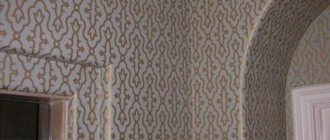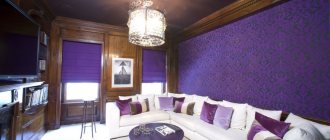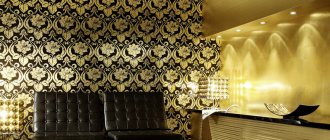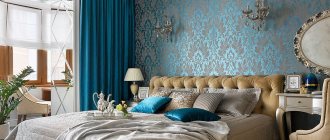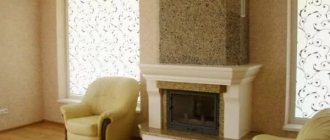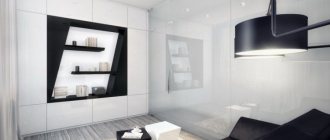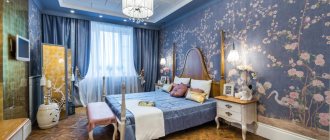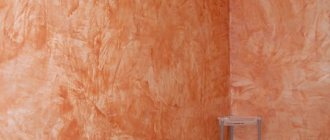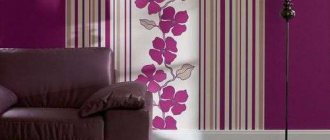Home / Ceiling design / Design solutions / Types, pros and cons of fabric wallpaper for walls
With the help of unusual finishing options you can transform any room. One of these unusual solutions in the interior can be fabric wallpaper for walls. This is a specific type of decoration that allows you to give the room a luxurious look. There are quite a lot of options for such coatings in stores, but not everyone is familiar with the pros and cons of such a design. Let's try to find out what is good or bad about this type of finishing, as well as its main features.
What it is
Before you stick fabric on the wall instead of wallpaper, you need to find out how they are produced and what initial components are used for this. Modern materials of this type are produced on special machines that cover a paper or non-woven base with a layer of textile fiber. Depending on which fiber is used, the appearance of the coating changes and it acquires special properties. This material looks very similar to real textiles and that is why such wallpapers are often called “fabric”.
Varieties
Modern fabric wallpaper for walls presented in construction stores can be of several types. The differences lie in the different materials used for the outer covering:
- Linen. The base is covered with a layer of flax fiber, which is of natural or artificial origin. Externally, they imitate real linen as accurately as possible.
- Silk. Despite this name, silk is practically not used in the manufacture of such coatings. Basically, the outer layer consists of viscose mixed with very small amounts of natural silk fibers. At the same time, everything looks very realistic.
- Felt. This type of fabric is made from natural felt or its artificial substitute - polypropylene. They are quite dense and thick, thanks to which they provide additional sound and heat insulation.
- Jute. The outer layer here is a natural fiber interspersed with coarse linen threads. This provides the canvas with good resistance to stains and durability. In addition, they do not attract dust.
- Velor. They differ from the others in the manufacturing method - a paint-coated paper base is passed through a special installation, which covers the not yet dried applied paint layer with small textile fibers due to an electrostatic field. They can have different textures and imitate fabrics such as velor, velvet, tapestry and so on.
- Jacquard. Their main difference is the large width of the canvas - up to three meters. This, on the one hand, increases the speed of finishing, and on the other, creates certain difficulties when carrying out repairs, since covering the walls with such a wide fabric will not be an easy task.
The choice is wide and in general it will be very large, since each type of wallpaper from the list presented above has several varieties. However, before you decide to stick fabric to the wall instead of wallpaper, you need to find out what advantages or disadvantages they have.
Types of fabric wallpaper
Textile wallpaper for walls has complex production technology. In this regard, they are most often manufactured in Europe. First, a fabric sheet is created to which the base is attached. This material is then dried in infrared chambers.
Another technology for making this coating is to attach threads, rather than a solid fabric, to the base.
Based on the type of base, textile wallpapers are divided into the following types:
- on a non-woven base (the main advantage is ease of installation);
- on a paper basis (environmental friendliness is an important advantage, but gluing them is harder than material on a non-woven basis);
- on a synthetic basis (this covering has a base made of thin foam rubber; walls decorated in this way are soft to the touch, they have good heat and sound insulation; but gluing the fabric covering requires certain skills).
Depending on the type of fabric, textile wallpapers are divided into certain classes.
Linen wallpaper
This natural and effective coating is the most inexpensive of all textile varieties. Due to the special manufacturing technology, it has threads of non-uniform color. Attracts less dust than other types of fabric finishes. With high-quality installation, a seamless surface is obtained. Suitable for dry vacuum cleaning only.
Silk wallpaper
This luxurious coating is widely used for wall decoration in bedrooms and offices, the interior of which is designed in Provence or Empire styles. There are two varieties - for painting and with a finished pattern.
Jute wallpaper
A material with a wonderful texture that allows you to hide small and medium-sized imperfections in the walls. Used in country or eco style interiors. Some types of jute wallpaper can be painted.
Their distinctive feature is ease of care (which other types of textile coverings cannot boast of), resistance to ultraviolet radiation, and good wear resistance.
Felt wallpaper
The coating, which creates the effect of a wall covered with a single piece of fabric, resembles velor. Its front layer is made of felt or propylene and applied to a paper base. In the first case, the material is more environmentally friendly, but more expensive; in the second, it is less environmentally friendly, but cheaper and easier to maintain. The covering with a propylene layer can be washed with a washing vacuum cleaner, while with a felt layer only dry cleaning with a vacuum cleaner is permissible.
Disadvantage - they absorb odors strongly.
Velor wallpaper
A stunningly beautiful coating that imitates the texture of expensive fabrics such as tapestry, velvet and others. But it is afraid of mechanical stress and is difficult to care for, so it is recommended to decorate walls with it only in bedrooms, subject to careful care, otherwise this material will quickly lose its external luster.
Jacquard wallpaper
The cover has a non-standard height of approximately 270 cm, which allows the number of seams to be kept to a minimum. Its special base prevents the glue from being absorbed, penetrating into the wallpaper layer and negatively affecting the quality of the design.
"Japanese grass"
This coating is made by fixing fiberglass threads to a paper backing; sage is sometimes used instead of fiberglass. The design is very unusual. This kind of finishing is very expensive. The pattern may differ even within the same roll, so installation is quite complicated.
Advantages and disadvantages
In order to make a more informed decision when planning repairs and choosing the type of design, you need to highlight the main advantages and disadvantages of a particular design option. It’s best to start with the advantages characteristic of textile coverings:
- They look great. This is the main “trump card” of this type of design. No other material will look so luxurious.
- Long service life - due to the strength of the outer layer, the coating can last for several decades if properly handled.
- Additional heat and sound insulation is created.
- Naturalness - the outer covering consists in most cases of real textiles or fibers. Therefore, fabric wallpaper for walls can be used in the interior of a children's room without fear for the health of children.
Unfortunately, such a beautiful design also has its drawbacks. When gluing fabric instead of wallpaper on the wall, you need to read the following disadvantages:
- Most varieties of such wallpaper attract dust and are quite difficult to clean.
- If paper is used as a base, the canvas will not be waterproof.
- They will absorb odors and therefore it is not recommended to use such materials to decorate the kitchen area.
- After gluing, paper-based varieties may become deformed and therefore, the best option would be varieties with non-woven bases.
- When exposed to sunlight, the material will gradually fade and lose its brightness.
In addition, fabric wallpaper for walls has a very high cost and that is why some people make it themselves. This is not a very complicated process, but getting a decent result comparable to factory products is very difficult.
Fabric-look wallpaper in the interior
Fabric-look wallpaper in the interior looks very impressive. This is a durable and practical alternative to expensive textile coverings. They are usually made from vinyl, which lends itself well to molding. Modern imitations of textiles are very similar to natural fabrics, but at the same time they are more wear-resistant, moisture-resistant, and do not fade. The basis for them is paper or non-woven fabric, which makes it easy to stick them on any surface.
How to choose wallpaper to match the fabric? This largely depends on what task you set for yourself when choosing furnishings for the room. Wallpaper should be combined with furniture; their choice depends on the size of the room, its lighting, and ceiling height.
Let's look at some samples:
Imitation of plain fabric. A very simple and effective solution that is suitable for almost all types of interiors.
See more fabric-look wallpaper options starting at RUB 990.
As with any other wallpaper, the rule that applies to fabric imitations is that for small and poorly lit rooms it is better to use light-colored wallpaper. This option is suitable for Scandinavian style, classics and neoclassics. Walls that look like they're upholstered in a light-colored fabric will work in many ways.
Dark wallpapers are also good in their own way. They usually require more space than light ones, but they look expensive, representative and cozy. They are appropriate in the bedroom, living room, office.
In addition to color, structure is also important for wallpaper. Wall coverings that imitate the moire effect characteristic of shiny, iridescent fabrics will look good in classic and modern interiors.
The imitation of rough homespun material looks very impressive in country, Scandinavian, and eco-design styles. This wallpaper goes well with natural wood. They are appropriate in the interior of almost any room: living room, kitchen, hallway.
See more fabric-look wallpaper options starting at RUB 990.
Another option that is suitable for Scandinavian style, country or other modern trends is imitation linen. Wallpaper colors can be very different, dark and light. The photo shows a dark sample, but the manufacturer offers other options.
A very interesting imitation of carpet will look good in the bedroom and living room. A room decorated with such wallpaper looks fresh and cozy. Its setting will be especially impressive if you use textiles with a similar pattern for the interior. The color scheme may also vary.
Wallpaper that imitates striped fabric is suitable for classic and modern interiors. Vertical stripes visually elongate the wall in height, and small horizontal stripes make it wider, so this pattern will increase the space of the room, even in a dark version. However, the manufacturer offers different colors.
Geometric patterns look impressive in interiors of a variety of styles. On this wallpaper, the pattern imitates embroidery with shiny thread. Such wallpaper will look good in a living room furnished in a modern or classic style, a hall, or an office.
See more fabric-look wallpaper options starting at RUB 990.
Wallpaper made of fabric with a damask pattern is a decoration of palace interiors. An imitation of such wallpaper will be good in a classic setting, be it a living room, office or bedroom.
What does it look like
It can be quite difficult to imagine how this or that material looks in design. To get a more complete idea of what fabric wallpaper for walls looks like in various interiors, you can view several photo examples of such finishing below.

